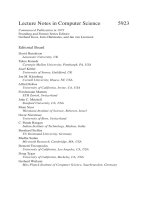Lecture02 architectural models of distributed systems
Bạn đang xem bản rút gọn của tài liệu. Xem và tải ngay bản đầy đủ của tài liệu tại đây (773.16 KB, 20 trang )
1/20/2016
IT4371: Distributed Systems
Spring 2016
Architectural Models of Distributed Systems
Dr. Nguyen Binh Minh
Department of Information Systems
School of Information and Communication Technology
Hanoi University of Science and Technology
Today…
Last Session:
Trends and challenges in Distributed Systems
Today’s session:
Architectural Models of Distributed Systems
1
1/20/2016
A Distributed System
A distributed system is simply a collection of hardware or software
components that communicate to solve a complex problem
Each component performs a “task”
Components
performing
tasks
C0
C1
Communication
mechanism
C2
Bird’s Eye View of Some Distributed Systems
Peer 2
Expedia
Server
Peer 1
Search
Reservation
Client
Client1 1
Search
Reservation
Client
Client2 2
Search
Reservation
Client 33
Client
Google Search
Airline Booking
Peer 3
Peer 4
Bit-torrent
Skype
• How would one classify these distributed systems?
2
1/20/2016
Classification of Distributed Systems
What are the entities that are communicating in a DS?
a) Communicating entities
How do the entities communicate?
b) Communication paradigms
What roles and responsibilities do they have?
c) Roles and responsibilities
How are they mapped to the physical distributed infrastructure?
d) Placement of entities
Classification of Distributed Systems
What are the entities that are communicating in a DS?
a) Communicating entities
How do the entities communicate?
b) Communication paradigms
What roles and responsibilities do they have?
c) Roles and responsibilities
How are they mapped to the physical distributed infrastructure?
d) Placement of entities
3
1/20/2016
Communicating Entities
What entities are communicating in a DS?
System-oriented entities
Nodes
Processes
Threads
Problem-oriented entities
Objects (in object-oriented programming based approaches)
Classification of Distributed Systems
What are the entities that are communicating in a DS?
a) Communicating entities
How do the entities communicate?
b) Communication paradigms
What roles and responsibilities do they have?
c) Roles and responsibilities
How are they mapped to the physical distributed infrastructure?
d) Placement of entities
4
1/20/2016
Communication Paradigms
Three types of communication paradigms
Inter-Process Communication (IPC)
Remote Invocation
Indirect Communication
Applications, Services
Remote Invocation, Indirect Communication
IPC Primitives
Middleware
layers
Internet Protocols
Inter-Process Communication (IPC)
Relatively low-level support for communication
e.g., Direct access to internet protocols (Socket API)
Advantages
Enables seamless communication between processes on heterogeneous
operating systems
Well-known and tested API adopted across multiple operating systems
Disadvantages
Increased programming effort for application developers
Socket programming: Programmer has to explicitly write code for communication (in
addition to program logic)
Space Coupling (Identity is known in advance): Sender should know receiver’s ID
(e.g., IP Address, port)
Time Coupling: Receiver should be explicitly listening to the communication from the
sender
5
1/20/2016
Remote Invocation
An entity runs a procedure that typically executes on an another computer
without the programmer explicitly coding the details for this remote interaction
A middleware layer will take care of the raw-communication
Examples
Remote Procedure Call (RPC) – Sun’s RPC (ONC RPC)
Remote Method Invocation (RMI) – Java RMI
Remote Invocation
Advantages:
Programmer does not have to write code for socket communication
Disadvantages:
Space Coupling: Where the procedure resides should be
known in advance
Time Coupling: On the receiver, a process should be explicitly waiting to accept
requests for procedure calls
6
1/20/2016
Space and Time Coupling in RPC and RMI
The sender knows the Identity of the receiver (space coupling)
Time Coupling
Request Message
doOperation
.
.
(wait)
.
.
(continuation)
getRequest
.
Select operation
.
Execute operation
.
Send reply
Reply Message
Sender
Receiver
Indirect Communication Paradigm
Indirect communication uses middleware to:
Provide one-to-many communication
Some mechanisms eliminate space and time coupling
Sender and receiver do not need to know each other’s identities
Sender and receiver need not be explicitly listening to communicate
Approach used: Indirection
Sender A middle-man Receiver
Types of indirect communication
1.
2.
3.
Group communication
Publish-subscribe
Message queues
7
1/20/2016
1. Group Communication
One-to-many communication
Multicast communication
Sender
Abstraction of a group
Group is represented in the system by
a groupId
Recipients join the group
A sender sends a message to the
group which is received by all the
recipients
Recv 2
Recv 1
Recv 3
1. Group Communication (cont’d)
Services provided by middleware
Group membership
Handling the failure of one or more group members
Advantages
Enables one-to-many communication
Efficient use of bandwidth
Identity of the group members need not be available at all nodes
Disadvantages
Time coupling
8
1/20/2016
2. Publish-Subscribe
An event-based communication mechanism
Publishers publish events to an event service
Subscribers express interest in particular events
Subscribers
Publishers
Publish (Event2)
Publish-subscribe Event
Service
Subscribe
(Event3)
Large number of producers distribute information to large number of
consumers
2. Publish-Subscribe (cont’d)
Example: Financial trading
Dealer process
9
1/20/2016
3. Message Queues
A refinement of Publish-Subscribe where
Producers deposit the messages in a queue
Messages are delivered to consumers through different methods
Queue takes care of ensuring message delivery
Advantages
Enables space decoupling
Enables time decoupling
Recap: Communication Entities and Paradigms
Communicating entities
(what is communicating)
System-oriented
•
•
•
Nodes
Processes
Threads
Communication Paradigms
(how they communicate)
Problemoriented
•
Objects
IPC
•
Sockets
Remote
Invocation
•
•
RPC
RMI
Indirect Communication
•
•
•
Group communication
Publish-subscribe
Message queues
10
1/20/2016
Classification of Distributed Systems
What are the entities that are communicating in a DS?
a) Communicating entities
How do the entities communicate?
b) Communication paradigms
What roles and responsibilities do they have?
c) Roles and responsibilities
How are they mapped to the physical distributed infrastructure?
d) Placement of entities
Roles and Responsibilities
In DS, communicating entities take on roles to perform tasks
Roles are fundamental in establishing overall architecture
Question: Does your smart-phone perform the same role as Google Search Server?
We classify DS architectures into two types based on the roles and
responsibilities of the entities
Client-Server
Peer-to-Peer
11
1/20/2016
Client-Server Architecture
Approach:
Server provides a service that is needed by a client
Client requests to a server (invocation), the server serves (result)
Widely used in many systems
e.g., DNS, Web-servers
Client
Server
Client
Client-Server Architecture: Pros and Cons
Advantages:
Simplicity and centralized control
Computation-heavy processing can be offloaded to a powerful server
Clients can be “thin”
Disadvantages
Single-point of failure at server
Scalability
12
1/20/2016
Peer to Peer (P2P) Architecture
In P2P, roles of all entities are identical
All nodes are peers
Peers are equally privileged participants in the application
e.g.: Napster, Bit-torrent, Skype
Peer to Peer Architecture
Example: Downloading files from bit-torrent
Peer 1 wants a file. Parts of the
file is present at peers 3,4 and 5
Peer 2
Peer 3 wants a file stored at
peers 1,2 and 6
Peer 1
Peer 3
Peer 6
Peer 4
Peer 5
13
1/20/2016
Architectural Patterns
Primitive architectural elements can be combined to form various patterns
Tiered Architecture
Layering
Tiered architecture and layering are complementary
Layering = vertical organization of services
Tiered Architecture = horizontal splitting of services
Tiered Architecture
A technique to:
1.
2.
Organize the functionality of a service, and
Place the functionality into appropriate servers
Airline Search Application
Display UI
screen
Get user
Input
Get data from
database
Rank the offers
14
1/20/2016
A Two-Tiered Architecture
How do you design an airline search application:
EXPEDIA Airline Search Application
Display user
input screen
Get user
Input
Display
result to user
Rank the
offers
Tier 1
Airline
Database
Tier 2
A Three-Tiered Architecture
How do you design an airline search application:
EXPEDIA Airline Search Application
Display user
input screen
Get user
Input
Display
result to user
Rank the
offers
Tier 1
Tier 2
Airline
Database
Tier 3
15
1/20/2016
A Three-Tiered Architecture
Presentation Logic
User view,
and
controls
Application
Logic
Data Logic
ApplicationSpecific
Processing
Database
manager
User view,
and control
ApplicationSpecific
Processing
Three-Tiered Architecture: Pros and Cons
Advantages:
Enhanced maintainability of the software (one-to-one mapping from logical
elements to physical servers)
Each tier has a well-defined role
Disadvantages
Added complexity due to managing multiple servers
Added network traffic
Added latency
16
1/20/2016
Layering
A complex system is partitioned into layers
Upper layer utilizes the services of the lower layer
A vertical organization of services
Layering simplifies design of complex distributed systems by hiding the
complexity of below layers
Control flows from layer to layer
Layer 3
Response
flow
Request
flow
Layer 1
Layering – Platform and middleware
Distributed Systems can be organized into three layers
1. Platform
Low-level hardware and software layers
Provides common services for higher layers
2. Middleware
Mask heterogeneity and provide convenient programming models to application
programmers
Typically, it simplifies application programming by abstracting communication mechanisms
3. Applications
Applications
Operating system
17
1/20/2016
Classification of Distributed Systems
What are the entities that are communicating in a DS?
a) Communicating entities
How do the entities communicate?
b) Communication paradigms
What roles and responsibilities do they have?
c) Roles and responsibilities
How are they mapped to the physical distributed infrastructure?
d) Placement of entities
Placement
Observation:
A large number of heterogonous hardware (machines, networks)
Smart mapping of entities (processes, objects) to hardware helps performance,
security and fault-tolerance
“Placement” maps entities to underlying physical distributed
infrastructure.
Placement should be decided after a careful study of application characteristics
Example strategies:
Mapping services to multiple servers
Moving the mobile code to the client
18
1/20/2016
Placement
Entities
Physical
infrastructure
Web search
indexing
User-interface
Mobile Code
Desktop
Smart-phone
Hi-performance
Server
Recap
We have covered primitive architectural elements
Communicating entities
Communication paradigms of entities
IPC, RMI, RPC, Indirect Communication
Roles and responsibilities that entities assume, and resulting architectures
Client-Server, Peer-to-Peer, Hybrid
Placement of entities
19
1/20/2016
Next Class
Identify different types of networks
Describe networking principles such as layering, encapsulation and packetswitching
Examine how packets are routed and how congestion
is avoided
Analyze scalability, reliability and fault-tolerance
of Internet
20









